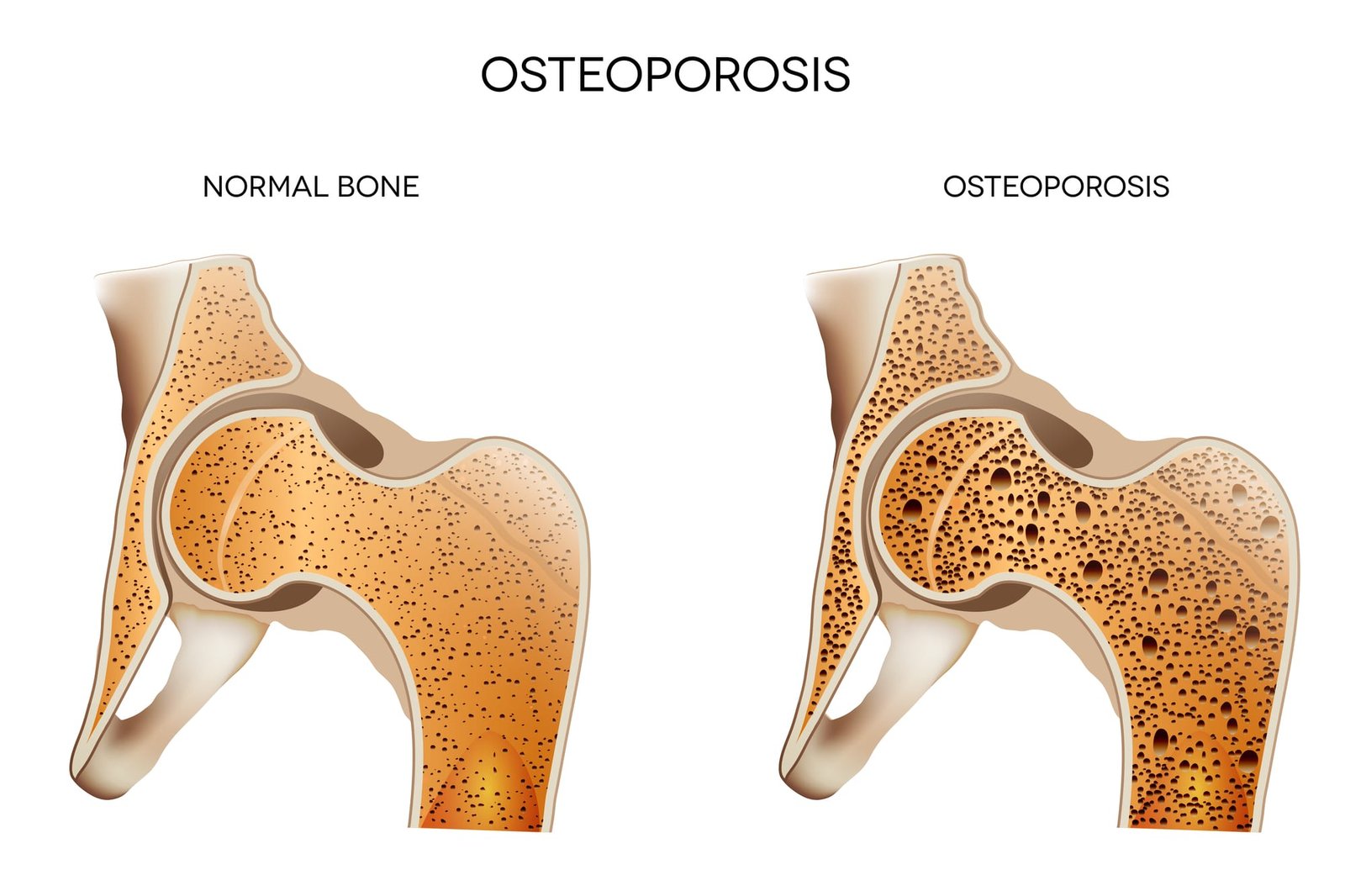OSTEOPOROSIS

Osteoporosis is a condition in which our skeleton, our bones lose their bone mass, become thinner, more fragile and break more easily. It appears in people over 45-50 years old and especially in women after menopause (postmenopausal osteoporosis). In people over 70-75 years of age, it is equally common in both women and men (senile osteoporosis). Once osteoporosis has set in, treatment is absolutely necessary to stop it getting worse and – if we can – to strengthen the skeleton a bit.
Symptoms
There are usually no symptoms in the early stages of bone loss. But once your bones are weakened by osteoporosis, you may have symptoms including:
- Back pain, caused by a fractured or collapsed vertebra
- Loss of height over time
- Crouching posture
Causes
Your bones are in a constant state of renewal — new bone is made and old bone is broken down. When you’re young, your body makes new bone faster than it breaks down old bone, and your bone mass increases. After the early 20s, this process slows and most people reach their peak bone mass by age 30. As people age, bone mass is lost faster than it is created. How likely you are to develop osteoporosis depends in part on how much bone mass you gained at a young age. Maximum bone mass is partly hereditary and also varies by ethnicity. The higher your peak bone mass, the more bones you have and the less likely you are to develop osteoporosis as you get older.
Risk factors
A number of factors can increase your chance of developing osteoporosis — including your age, ethnicity, lifestyle choices, and medical conditions and treatments.
Immutable risks
Some risk factors for osteoporosis are out of your control, such as:
- The gender. Women are much more likely to develop osteoporosis than men.
- Age. The older you get, the greater your risk of osteoporosis.
- Family history. Having a parent or sibling with osteoporosis puts you at greater risk, especially if your mother or father suffered a hip fracture.
- Body frame size. Men and women who have a small frame tend to be at higher risk because they may have less bone mass to draw on as they get older.
Prevention
Osteoporosis is a condition characterized by weakened bones, which makes them more prone to fractures. Although it is more common in older adults, taking preventive measures early can greatly reduce the risk. Here are some key strategies to prevent osteoporosis:
- Calcium-rich diet: Ensure adequate intake of calcium, a mineral vital for bone health. Dairy products and greens are excellent sources of calcium.
- Vitamin D: Combine your calcium intake with adequate vitamin D, as it helps the body absorb and use calcium effectively. Sunlight, oily fish and vitamin D supplements can help maintain optimal levels.
- Healthy lifestyle choices: Limit alcohol consumption, quit smoking, and limit caffeine consumption. Excessive alcohol and tobacco use can contribute to bone loss, while high caffeine intake can affect calcium absorption.
- Bone density screening: Periodic bone density screenings, especially for postmenopausal women and older adults, can help identify early symptoms of bone loss and guide preventive measures.
Treatment
If osteoporosis is diagnosed, a multifaceted approach is often used to manage the condition and prevent further bone loss. Here are the key components of osteoporosis treatment:
- Medications: Various medications and hormone-related treatments may be prescribed to slow bone loss and reduce the risk of fractures.
- Calcium and Vitamin D Supplements: In addition to dietary sources, supplements may be recommended to ensure adequate calcium and vitamin D levels.
- Lifestyle modifications: Adopting a bone-healthy lifestyle is vital. This includes regular weight-bearing exercise, quitting smoking, moderating alcohol and caffeine intake, and maintaining a balanced diet.
- Fall prevention: As fractures are a major concern for people with osteoporosis, taking steps to prevent falls is essential. This may include home modifications, balance exercises, and use of assistive devices.
- Regular follow-up: Regular follow-up with doctors, including a bone mineral density test, helps monitor the effectiveness of treatment and allows for adjustments as needed.
Remember, early detection, lifestyle adjustments, and appropriate medical interventions are key ingredients to effective osteoporosis management.
- Category
- ΠΑΘΗΣΕΙΣ ΕΝΗΛΙΚΩΝ

